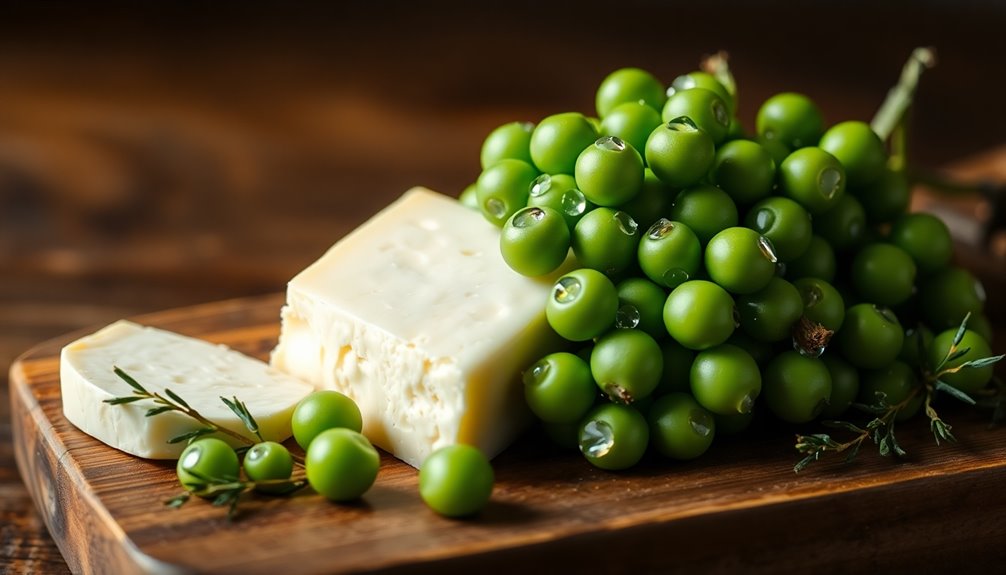Pea protein is revolutionizing cheese-making, allowing you to enjoy cooking cheese that mimics the flavor and texture of traditional varieties. This hybrid cheese contains up to 25% pea protein, reducing dairy content while maintaining essential taste. It's a sustainable option that's both nutritious and environmentally friendly. Perfect for grilling or frying, you can indulge without compromising your values. Want to discover how this trend is shaping the future of cheese? Keep exploring!
Key Takeaways
- Pea protein can replace up to 25% of milk proteins in cheese, maintaining similar flavor and texture.
- Hybrid cheeses blend plant-based and dairy components, offering versatile cooking options while retaining shape for grilling or frying.
- The use of pea protein enhances nutritional profiles, increasing dietary fiber while preserving essential amino acids from dairy.
- Pea protein cheese is more sustainable than traditional dairy, aligning with consumer demand for eco-friendly food choices.
- Ongoing research and consumer feedback are essential for improving the taste and texture of hybrid cheeses.

Peas are stepping into the spotlight in the world of cheese production, particularly in creating hybrid cheeses like paneer. By incorporating pea protein, cheese makers are reducing milk content without sacrificing taste or texture. This innovative approach not only meets consumer demands for sustainability but also enhances the nutritional profile of the cheese.
Pea protein is revolutionizing cheese production, creating sustainable and nutritious hybrid cheeses like paneer without compromising on taste.
You'll find that pea protein is a more sustainable option compared to other plant-based proteins, like soy, especially since it can be locally sourced in Europe. This local sourcing minimizes the climate footprint associated with dairy farming. Researchers at the University of Copenhagen have focused on hybrid cheeses, particularly paneer, which is known for its ability to hold shape when heated. This makes it ideal for grilling or frying, offering a versatile cooking option.
In fact, up to 25% of milk proteins can be replaced with pea protein without altering the cheese's texture or taste. While pure plant-based cheeses often struggle to replicate the creamy consistency of dairy, hybrid cheeses strike a perfect balance. The combination of plant and dairy components creates a product that meets consumer expectations for flavor and mouthfeel, which is crucial for wider acceptance.
The inclusion of pea protein not only increases dietary fiber but also maintains essential amino acids from the milk components, making hybrid cheeses nutritionally beneficial. Interestingly, these cheeses can also be paired with cheesy peas to create a gourmet side dish, offering sustainable alternatives without compromising on quality. They can be grilled, baked, or fried just like traditional cheeses.
As the market for these innovative products expands, particularly in Western cuisine, consumer feedback will play a vital role in refining taste and texture. With ongoing research and collaboration among food scientists, the future of hybrid cheeses looks promising, paving the way for delicious, sustainable cooking options. Enjoying paneer made from peas means indulging in both flavor and responsibility.
Frequently Asked Questions
Are There Any Allergens in Pea-Based Cooking Cheese?
When you're considering pea-based cooking cheese, it's important to know that while pea protein isn't one of the 14 major allergens, it can still trigger allergic reactions in some people.
If you have a legume allergy, be cautious, as allergies to peas can overlap with those of other legumes.
Always read labels carefully to ensure you're aware of any potential allergens before trying new products.
Your safety should always come first!
How Is Pea Cooking Cheese Made?
To make pea cooking cheese, you start by grinding yellow peas into flour.
Then, you mix this flour with other ingredients, including pea protein and possibly some milk proteins for texture.
Next, you ferment the mixture to enhance flavor and improve consistency.
After that, you may apply pressure to shape the cheese before letting it ripen overnight.
This process creates a nutritious, plant-based alternative to traditional cheese that's both flavorful and sustainable.
Can Pea Cooking Cheese Be Frozen?
You might find that freezing pea cooking cheese isn't straightforward.
While general plant-based cheeses can struggle with texture changes when frozen, there's limited research on pea cooking cheese specifically.
If you decide to freeze it, consider blanching the peas beforehand to help maintain their quality.
However, be prepared for potential changes in texture after thawing.
It's best to use it fresh for optimal flavor and consistency.
What Dishes Pair Well With Pea Cooking Cheese?
You might think that cheese can only pair well with traditional ingredients, but that's not true!
When it comes to pea cooking cheese, you can elevate your dishes in exciting ways.
Try it in creamy pasta sauces or as a topping on burgers.
It makes a delightful filling for stuffed peppers or a rich addition to lasagna.
You'll love how it enhances flavors in vegetarian stir-fries and creamy soups.
Is Pea Cooking Cheese Suitable for Vegan Diets?
Yes, pea cooking cheese is definitely suitable for vegan diets.
It's made entirely from plant-based ingredients, offering a delicious alternative to dairy cheese.
You'll enjoy its creamy texture and flavor in various dishes without any animal products.
Plus, it provides a higher protein content than many traditional vegan cheeses, helping you meet your nutritional needs.
Whether you're making pasta or a pizza, it's a great choice for your meals!
Conclusion
Incorporating peas into your cooking opens up a world of flavor and creativity. You'll savor the creamy texture, delight in the rich taste, and enjoy the versatility it brings to your dishes. Whether you're melting it over pasta, spreading it on toast, or blending it into sauces, this cooking cheese will elevate your meals. So grab those peas, experiment with recipes, and let your culinary imagination run wild. You won't just cook; you'll create, you'll impress, and you'll enjoy!









